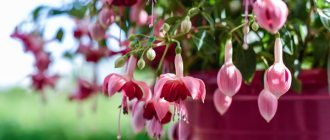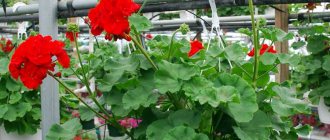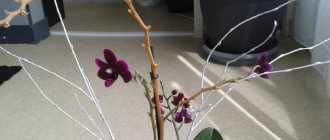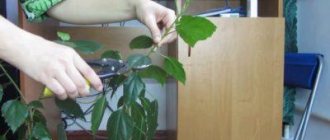Wintering fuchsia in an apartment. How to properly prune and preserve a plant?
Before wintering, fuchsia is pruned, not fertilized and sprayed with a biological product purchased at a flower shop to protect against pests.
Basement or cellar
How to keep a plant in the basement, and what kind of care does it need?
Not everyone has the opportunity to organize the wintering of fuchsia on a glassed-in warm loggia of an apartment or in a bright greenhouse. Wintering goes well in a “dark” room - in the basement, garage or cellar. Before moving it to one of the rooms listed above, trim it and remove the leaves. In the dark, it also “breathes”, just like in the fresh air, consuming nutrients and evaporating water. The room where it will be located must have ventilation. Otherwise, with its appearance, the humidity in the air will increase, which will provoke an outbreak of fungal diseases. The optimal temperature for wintering fuchsia is in a cellar or basement, where the temperature is – +10⁰С.
Look
In the apartment
Not all gardeners have a basement or garage where they can move a pot of fuchsia for the winter. Some have no choice and are forced to bring it home. You can also provide a comfortable winter in an apartment, but only if it is regularly ventilated.
At the beginning of autumn, fuchsia cuttings are transplanted into “poor soil” with a small content of humus for the winter. This slows down the growth of young bushes. If in winter a gardener notices that they are sprouting, he should ruthlessly cut them off and open the window wider to lower the temperature in the room. The shoots do not need to be thrown away. You can try to root them by placing them in water on a well-lit and “warm” windowsill.
If fuchsias wintering in the basement are watered rarely - 1-2 times a month, then plants that winter in the apartment are watered more often.
Note! Due to central heating, the earthen ball dries out faster, and the lack of moisture leads to the death of the flower.
On the day when the gardener brings the fuchsia pot home, he must open the window and set the double-glazed window to minimal ventilation. The window should always be open, except on days when it gets very cold outside.
During the dormant period, fuchsia is even more capricious than during the period of active growth and flowering. It reacts poorly to excess and lack of moisture. Lack of necessary conditions for wintering, increased air humidity and temperature lead to the appearance of insects. Fungicides and insecticides do not always help in combating them, and the plant can only be thrown away.
How to care for a flower on the windowsill?
- Insulating the bottom with polystyrene foam during transplantation helps to avoid rotting of the roots due to cold masses constantly rushing into the room through a slightly open window.
- Dry air protection will be needed if the apartment is hot. To do this, simply cover the fuchsia with plastic wrap.
- Watering should not be frequent or abundant.
- The plant must be treated with special preparations to protect against pests.
- In December and January, the plant is illuminated with lamps, since there is not sufficient lighting during the day.
Maximum ventilation of the window sill. The pot is placed as close to the glass as possible.
Do I need to trim?
You definitely need to prune the plant for the winter, because this is an important stage in growing and it is very important to do it correctly. It is held twice a year. The first time is in the fall, when they move it from the garden to the basement or apartment and it is necessary to provide suitable conditions for hibernation, and the second time is in the spring, in order to form a beautiful bush. Fuchsia is pruned in the fall after it has finished blooming, so as not to provoke the growth of 1-2 trunks and the bush stretching upward. This procedure is necessary for the proper development of the flower next spring.
Pruning after flowering
After the bush has flowered, it is recommended to partially cut off the branches. This will allow the bush to gain strength. The procedure is carried out twice a year: in September and April. First, all wilted and dry stems are removed from the plant. The next step is for the gardener to cut off all the young shoots. Then the fuchsia is formed to the desired shape. The plant can wrap around supports. Therefore, the stems can be braided or intertwined with each other. In the fall, the gardener should inspect the fuchsia for the absence of pests and diseases. If detected, the diseased branch should be cut off, including the healthy part.
In order for a plant to bloom long and profusely, it needs to gain strength. For this, timely cutting is used. The later the fuchsia branches are pruned, the longer the plant takes to bloom. It is better to prune the bush in the fall and immediately after wintering. In the autumn months this is done as a preventative measure. Remove damaged, thin shoots from the bush.
Repeat the procedure from February to March. Manipulations with pruning shoots are necessary to form a beautiful plant crown. This is done so that there are buds at the ends of the branches. First, remove all weak branches. They are unlikely to bloom, and if they do, the flowering will be weak. After this, you need to cut off dry branches and thin shoots. Then comes the pruning of branches that are directed to the center of the bush. So, the bush will stop thickening and will bloom profusely.
Care after pruning
In order for the plant to be healthy and strong, it is important not only to prune it correctly, but also to provide care after the procedure. After the procedure, you should place the pot with the bush so that scattered sunlight falls on it
Windows facing the north or east side of the house are best. If the plant does not have enough light, the shoots will weaken and the flowers will be sparse and small.
It is important to choose the right watering mode. Water fuchsia moderately after pruning.
It cannot be flooded, but the soil should not dry out. Watering is carried out with soft, settled water. In winter, the flower is watered twice a week, in spring once or twice a week.
After the fuchsia has overwintered, it is necessary to introduce fertilizing. Fertilize the bush from spring to autumn. To do this, you can purchase special formulations for flowering plants. Fuchsia should not be overfed. Otherwise, the bush quickly grows green mass, but blooms sparingly. Fuchsia devotes all its strength to the growth of leaves and shoots.
There is no need to feed the bush once every two weeks. The fertilizing composition should include magnesium and nitrogen. Compositions with potassium and phosphorus are also useful for fuchsia. Fertilizing is applied only to moist soil. Organic compounds are diluted so that the water concentration is twice as high as recommended in the instructions for use. Otherwise, the fuchsia will bloom worse and will quickly begin to grow upward.
In winter, gardeners recommend completely abandoning fertilizer. With the right approach, the plant quickly recovers after pruning and gains strength. After a couple of months, it begins to actively form buds and bloom with bright, unusual flowers. This plant will decorate a flower garden or home windowsill. Despite the fact that this is a heat-loving flower, it is grown in flower beds and in apartments.
Wintering fuchsia in the refrigerator. Preparing fuchsias and pelargoniums for wintering: tips from Yulia Minyaeva
At the beginning of the season, many summer residents take pots to the dacha and take them out into the open air. With the onset of cold weather they return home. A plant like this is often planted in the spring, but in the winter it must be dug up and stored for storage.
Geraniums We will talk about how to prepare pelargoniums (geraniums) and fuchsias for wintering.
fuchsia
When bringing a fuchsia (or other indoor plant) into the house that has stood outdoors throughout the warm season, you need to be aware that unwanted “guests” can also enter along with it. These are whiteflies, spider mites, and aphids. Quite quickly, all these pests will spread to other house plants, and then to the seedlings, which you will begin to grow at the right time. To make the autumn transition process painless, it is necessary to pay special attention to pest control. The plant may look completely clean, but after placing it in a warm place, small white butterflies - whiteflies - appear out of nowhere. And the most unpleasant thing is that they settle not only on plants, but also in crevices, where they spend the winter well and wait for seedlings.
Delicate fuchsia A good treatment for Fitoverm, but often it is not strong enough, so I use Aktara. This is a reliable drug, but you need to remember that spraying must be repeated after 5-7 days. You can choose products for treating plants against pests on our market, where products from various online stores are presented. View a selection of the drug "Aktara". Before storing the fuchsia in the cellar (temperature +4...+5°C), I water it, trim it and make a paper cap in the same way as for pelargonium. This will be discussed in more detail below. No more manipulations are required, the plant overwinters well without additional watering or anything else.
pelargonium (geranium)
pelargonium, unfortunately, does not tolerate our winters, and therefore requires temporary relocation to more acceptable conditions. Many people think about how best to preserve this plant during the cold period. I will share my experience. After it's time to remove the geranium from the street, I move the plant into the house, where it sits for about 2 weeks. Watering stops completely, since in winter the geranium enters a dormant period; it almost never blooms at this time.
Pelargonium does not tolerate our winters. If your pelargonium grew in a flowerbed, then in the fall you can dig it up, place it with a lump of earth in a paper (not plastic!) bag, tie it on top and put it in the cellar. Another option is more suitable for plants that were in outdoor flowerpots in the summer. Such pelargonium needs to be transferred to a temporary pot. For further manipulations, you will need a water-based stationery proofreader (for example, “Stroke”), sharp pruning shears, newspapers, paper tape and a hydrogel soaked in water. I cut off all the green branches of the plant to the woody part, leaving a not very beautiful “snatch”. All green leaves from this snag are also removed. Cuts on the branches are treated from rotting with the “Stroke”, the plant itself is watered a little.
A paper cap is formed from newspapers. Now a paper cap is formed from newspapers using tape, and the newspapers are wrapped on top. In this form, the plant is lowered into the cellar (temperature +4...+5°C) and stored all winter.
Newspapers are wrapped on top. In early spring, after removing the cap, the plants do not look very attractive, but after pruning and adding nutritious soil, they quickly wake up.
cuttings
I prepare cuttings from the cut green mass of pelargonium and root them. To do this, I remove the peduncles and most of the leaves, trim them from the bottom to lush greenery and lower them into the prepared hydrogel.
Cuttings are prepared from the cut green mass. After a while, roots will appear, and then I will plant them in pots and place them on a cool windowsill. In the spring I will have at my disposal several fully mature plants with a good root system that can be planted in flower beds and flowerpots. In the next video
clip you will see in detail how pelargonium and fuchsia are prepared for winter. You can also learn how and with what help it is convenient to fix roses when bending down to the ground, and how to insulate them after stable cold weather sets in. I hope my experience in preparing flowers for winter will be useful to you. Share in the comments how you preserve your fuchsias and pelargoniums until spring.
Flower propagation
You can propagate the bush yourself at home. Reproduction methods:
- seeds;
- cuttings.
In the first case, the “new” fuchsia may be very different from the parent plant, since it is self-pollinating or bees take part in pollination. When cutting from a shrub, it is necessary to cut off a shoot whose length does not exceed twenty centimeters. After the gardener removes the leaves from the bottom of the plant, the root must be placed in purified water. When young roots appear, the cuttings should be transplanted into the ground.
When the fuchsia grows enough, it needs to be transplanted into a larger flowerpot. Replanting should be done every year in autumn or spring, providing free space for growing roots.
Reproduction by cuttings
- It is necessary to select a green apical shoot with two or three leaf axils. With a well-sharpened knife, cut the shoot at an angle of approximately 45 degrees. Then you need to leave the cutting for literally ten minutes. Large leaves (if there are a large number of them) must also be trimmed to facilitate rooting.
- Next, you need to “spray” the cut with a root formation stimulator (for example, “Kornevina” is perfect).
- The cuttings need to be rooted in a light soil mixture. Then you need to prepare a container and put the moistened mixture into it to a depth of three centimeters, deepen the cutting there and moisten it using a sprayer.
- To increase the degree of humidity you need to use a transparent bag. You need to put a container inside it, inflate the bag, tie it, and then put the whole structure on a well-lit windowsill. In this case, there should be no direct exposure to the sun on the cuttings (the optimal temperature is 20-25 ℃).
- Once a day (or even once every 2 days) you need to untie the bag for ventilation. If necessary, you can spray the cuttings and soil, thereby preventing drying out.
- After about 2 weeks, small roots will appear. When the roots grow, the cutting can be transplanted into a small container. It is important to use light soil. The pot with the cutting inside must be wrapped again in a bag, which no longer has to be tied, you can only raise the “walls”.
- After several days (up to seven), the bag can be removed, given that the plant is not lethargic. If this happens, it is necessary to create conditions that are even closer to greenhouse conditions. You need to spray the fuchsia, inflate the bag, tie it and wait for the plant to recover, not forgetting about proper care.
Propagation by seeds
- You need to grow fuchsia with seeds in February, using light soil. You can buy soil at a garden store. However, it is not difficult to make your own soil mixture from turf soil, peat and sand (3:2:1). Before sowing, the soil must be compacted, moistened and sprayed with a pink solution of potassium permanganate.
- The tray must be covered with cellophane and placed on a warm and well-lit windowsill. The temperature should be between +18° and +22°. It is important to ensure that the sun's rays do not fall directly on the tray. If the ground is wet, you need to lift the film several times a day to remove condensation. If the soil is dry, you should carefully spray the soil around the sprout (the water should be at room temperature). After about a month, small shoots will begin to appear. At this point, you need to start removing the cellophane from the tray for a long time so that the seedlings gradually get used to room conditions, and then the shelter can be removed altogether.
Important!
The seeds need to be laid out in a tray and distributed over the substrate, without covering them with soil, but only slightly pressing them into it. If this is not done, then without light the seeds will not be able to germinate.
When the second pair of leaves appears, the sprouts need to be planted in separate small containers. It is important to water the plant to prevent the soil from drying out. Spraying should be carried out from time to time and the sprouts should be fed with mineral fertilizers twice a month.
Fuchsia on the balcony in winter. General rules for caring for shrubs
In order for an exotic flower to always please its owner, it needs to create appropriate conditions for growth, flowering and rest during the off-season. Therefore, everyone is interested in how to care for fuchsia growing in open ground and at home in a flower pot.
Let's look at the basic rules for caring for fuchsia at home
- Watering mode. Fuchsia belongs to the category of moisture-loving plants. It responds equally well to both root watering and external spraying. The shrub should be watered daily in small portions. A signal that the plant requires moisture is when the top layer of soil dries to a depth of 1 cm or more. But you should not overuse watering. Excess moisture leads to the development of mold and rotting of roots. You can avoid waterlogging by creating a drainage layer at the bottom of the flowerpot. For this, expanded clay or well-cleaned pebbles are used.
Flower lighting. Despite the fact that fuchsia is a heat-loving flower, it is not recommended to place it in direct sunlight. For this plant, reflected light and even partial shade conditions are quite enough. When choosing a location for a shrub, you need to take into account the contrast factor. Plants with dark-colored flowers need more color, while bright, light-colored flowers do much better in the shade.
Selection of soil mixture etc. It is best to use black soil with the addition of leaf humus for growing shrubs. This composition will provide the root system with nutrients and give it freedom to grow. The plant needs constant feeding. For blooming fuchsia, you need to use biological fertilizers with a minimum nitrogen content. Fertilizers can be applied along with irrigation liquid or by adding them directly to the soil. When winter comes, the plant does not need feeding. It enters a state of rest when there is no need for nutrients.
Temperature maintenance. Despite the fact that fuchsia is native to hot countries, it reacts extremely negatively to high temperatures. When it increases above +25 ºС, the bush becomes lethargic, does not bloom or bear fruit. In summer, the flower must be protected from direct sunlight. To do this, you need to put the flowerpot in a cool place, and create artificial shade for the flower garden.
Description of the plant
The plant, due to its flexibility, can develop as an ampelous or pyramidal type.
Fuchsia is often grown as an elegant standard tree. The branches of the ballerina are plastic, forming a crown that cascades down. Fuchsia flowers belong to the axillary variety, they are single and hang downwards. Each flower consists of a corolla-shaped cup, which has four pointed petals. The pistil and bright stamens protrude outward.
Fuchsia was bred more than three hundred years ago: in 1695 by the French botanist C. Plumière. He named the plant in honor of the German botanist Fuchst, who subsequently developed more than 100 varieties of fuchsia.
Ballerina flowers are simple, double and semi-double. They are distinguished by a rich palette of shades: there are white, cream, pink, lilac, orange and even purple. There are multi-colored flowers that combine 2-3 tones.
Fuchsia blooms long and abundantly; during this process, the peduncles droop for a long time, leaning down and, ultimately, wither. Ballerina has a powerful and developed root system, thanks to which it easily tolerates transplantation and propagation. It bears fruit with medium-sized elongated berries that are edible.
Various tinctures, liqueurs, and jams are prepared from fuchsia fruits that grow naturally.
Fuchsia in the apartment. Fuchsia at home and in the garden - how to grow
They are called little ballerinas in fluffy colorful skirts, they are charming and original, and the variety of colors and shapes of flower-skirts is amazing.
If you don't already have this beautiful flower, be sure to get one. Fuchsia can grow at home - it is a houseplant, but in summer it can be planted in a flowerpot in the garden, and it will become the best decoration for your potted garden.
Ampelous forms of fuchsia grow well in hanging flowerpots, forming continuous flowering cascades.
How to grow fuchsia
You can buy fuchsia as an adult plant, or you can buy a cutting and grow it. Cuttings are rooted in water or loose soil with sand. It is better to first plant a young plant in a small pot so that the roots gradually master the entire soil, and only then replant it into a larger volume.
Conditions for fuchsia
Fuchsia is a light-loving plant and is best grown in the brightest window, but in summer it is better to shade the south window a little. It will be good for her on the loggia or balcony.
In the garden, it is better to place a container with fuchsia in light through partial shade - it will not be very comfortable in the bright sun. In extreme heat, flowering stops, the bush begins to dry out, the leaves dry out and may fall off.
Important! Fuchsia does not tolerate overheating of the root system, and to prevent the roots from overheating in the heat, it should be planted in a large ceramic pot.
When fuchsia begins to bloom, it is all covered with its wonderful flowers. Fading flowers must be removed to prevent the formation of seed pods, which can take up all the nutrition.
Remember! When fuchsia blooms, it is undesirable to turn it and rearrange it - this can lead to the dropping of buds.
Abundant flowering takes a lot of energy and nutrients, so fuchsia is regularly fed with complex fertilizers for flowering plants - approximately once every 7-10 days. Water fuchsia regularly and abundantly - under no circumstances should the plant be allowed to dry out. I really like fuchsia and spraying.
Fuchsia in winter
With the onset of cold weather, fuchsia growing in flower pots in the garden is transferred to a cool room (with a temperature of 10–15 ° C) or stored in a dark basement; it is advisable to put indoor fuchsias there as well. From time to time, check the plants to ensure that the soil in the pots is slightly moist.
After such a cold winter, fuchsia will bloom much better next summer.
in spring
In the spring, the plants are transplanted into new containers using fertile soil with the addition of sand. Then the bush is pruned, shortening the grown and elongated shoots. The more often you prune fuchsia, the more side shoots it forms and, accordingly, the more flowers.
Cuttings can be used to root and grow new plants.
There are many beautiful varieties of fuchsias - both bush and hanging. You can plant several plants of different varieties in one pot - it will be a magnificent mixture of luxurious flowers.
Tools and their disinfection
The gardener should use a knife or garden shears when processing the plant. Before the procedure, the instrument is disinfected to prevent the development of viruses. The scissors are treated with a product containing alcohol (spray, wipes). Kerosene, potassium permanganate or bleach are also used. Place the instruments in an antiseptic solution for several minutes and wipe them with a clean, dry cloth.
Preparing a houseplant for winter
From time to time it is important for every plant to rest. If the fuchsia is in a room with heating, it is fed and watered as in summer, then the plant will not have the strength to bloom
In addition, the bush grows quickly and occupies a large area. Before wintering, you should examine how much the branches have grown.
In the first year of fuchsia growth, you should not overwinter with shoots that are too long. Therefore, they are cut short, leaving a length of about 15 centimeters. After the bush is formed, all weakened and diseased branches are cut off. You should not thicken the bush too much, otherwise it will not grow well. The plant should only have strong shoots left, the rest should be cut off, leaving 1/3 of the shoots.
You need to pay attention to semi-ampeloid forms. Their weak shoots break under the weight. Only strong branches are left on the bushes. To switch to winter mode, plants need to drop the temperature to +10 degrees. Therefore, fuchsias are put away in the basement or placed on a glazed balcony. In such a room, the temperature should not be below zero so that the indoor plant does not die.
If there is no cooler place, then you can simply choose a cold corner in the house. When the fuchsia continues to grow, fresh shoots are cut with scissors or pinched.
Before leaving the winter hut, all diseased parts of the plant are cut off and overgrown branches are removed. To make the crown more lush, it is recommended to pinch the tops of the shoots after growth begins. Flowering occurs no earlier than two months after the procedure. In order for the plant to actively produce buds in the summer, it is necessary to pinch it no later than April.
Possible diseases during wintering
Most often, during wintering, fuchsia is affected by a fungal disease called rust . The disease may appear due to poor living conditions. If the grower did not follow the recommendations, and the room was warm, humid and dark, then there is a high probability that the flower will get sick. As a preventative measure, they are treated with a 1% solution of Bordeaux mixture, but very often prevention is neglected, and when brown spots appear on the plant, flower growers reproach themselves. A plant affected by rust will most likely die; if it is not isolated in time, then other crops may die along with it.- When the air is over-humidified, gray rot . It is quite easy to identify the affected part of the flower: it is soft and watery, and there are white spots on the leaves. The disease can be cured by cutting off damaged leaves and treating them with special preparations. After this, you need to change the microclimate so that gray rot no longer appears.
Growing any ornamental plant requires compliance with the rules of agricultural technology. We advise you to read our articles on how to plant fuchsia at home, as well as how to properly replant a flower in order to get abundant flowering in the future.
Awakening in the spring
In order for fuchsia to successfully enter the active phase in the new season, it must be properly “awakened” at the end of wintering. This should be done gradually, without sudden fluctuations in conditions of detention. The best time for fuchsia to awaken is considered to be the end of February - the beginning of March.
Let us note the main points of this process.
- Move the flowerpot with the flower to a warm, well-lit place without direct sunlight. In this case, you should try, if possible, to change the temperature not sharply, but gradually increase it by small temperature marks.
- Start progressive watering, gradually increasing its volume. The best time to water is when the sun sets.
- Fertilize with complex mineral fertilizers or fertilizers specially designed for fuchsias (sold in garden centers).
- After storing in a dark room, the plant is already pruned before wintering; in the spring, only the remnants of dry shoots and leaves are removed.
- If the fuchsia has wintered in an apartment, it is necessary to cut off thin, weak shoots, incorrectly directed, old branches, and cut off young ones by 1/3.
- Place a filled reservoir of water next to the flower so that the plant is evenly saturated with moisture from the inside and outside, so microcracks will not appear on the branches.
After about a month, new buds and flower buds appear on the young shoots.











